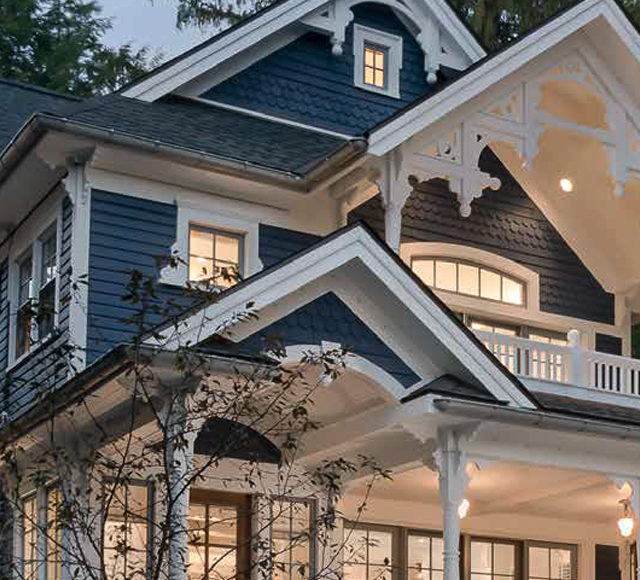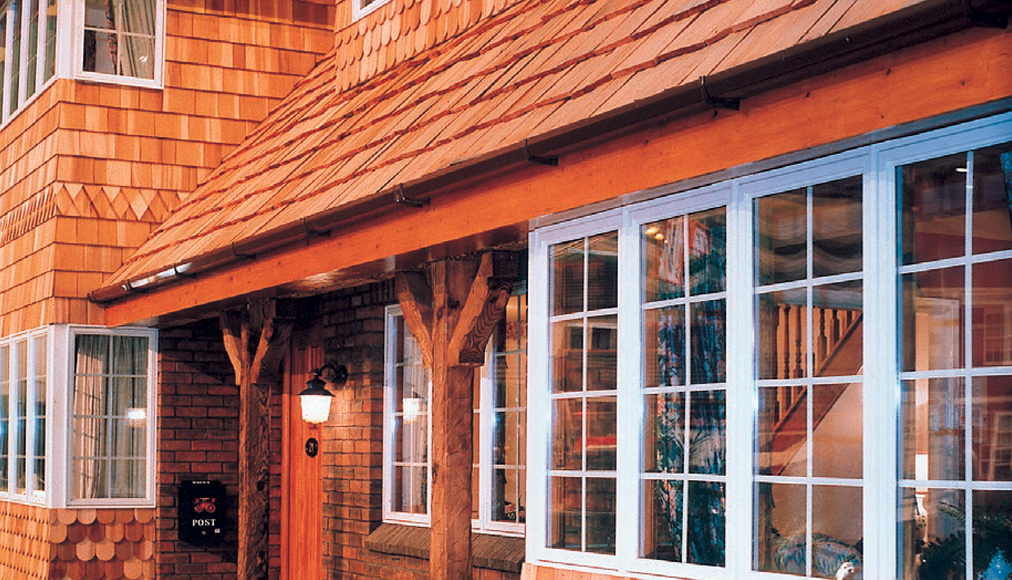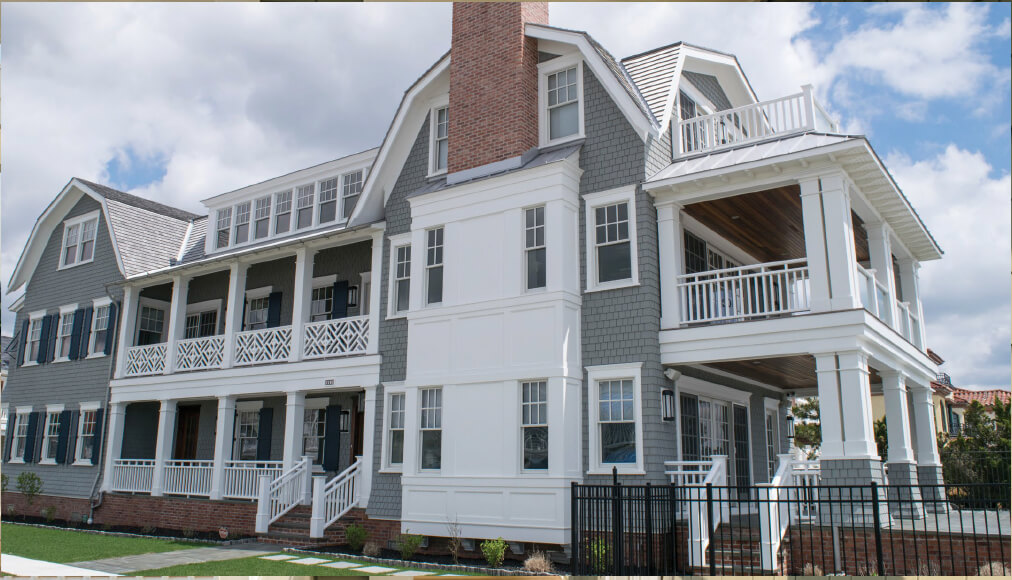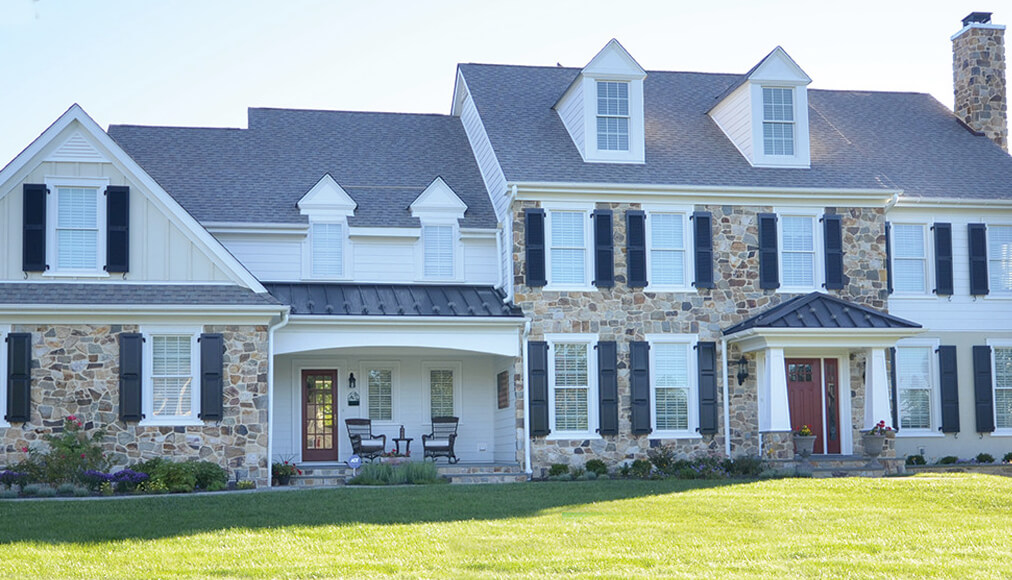Selecting the Right Materials for Your Project: Best Exterior Home Siding Edition

- Written by: jlbmdev

If you want to refresh the look and feel of the outside of your home, new siding is a great place to start. But with the wide range of house siding options available, it can be difficult to find the right product.
In the fifth installment of our Best Materials Series, we’ll simplify the process of selecting the best exterior home siding options by breaking down the pros and cons of each option. You’ll also find information about how to calculate the correct amount of siding and the benefits of professional installation.
Your home has a large amount of footage and when you decide to reside it, you’ll need to invest time and money into the project. Like any big investment, you’ll need to do some research before you buy. Once you can answer these questions, you’ll have a better idea of what type of siding is best for you.
Your location is going to help you determine what home siding option is best for you. Where is your home located and what are the typical weather conditions?
It’s important to know this because various types of weather affect exterior siding options differently. A sunnier location can cause fading on vinyl products and cause them to become brittle. A wetter climate can cause mold and rot on wood siding.
As a homeowner, you know maintenance is part of the deal. If you’re an experienced homeowner or someone with better-than-average DIY skills, then you can handle choosing a siding that requires more maintenance, like wood, brick, or stone veneer siding on your home.
However, if you’re new to homeownership or aren’t handy with power tools, vinyl or PVC siding might be a better choice since you’ll only need to power wash it. You won’t need to worry about repairing damaged siding from rot or if pieces of stone fall off.
So selecting a siding comparable to your skillset is important.
Depending on the size of your home, it could need a lot of exterior siding to cover it. Think about what you want to spend or how much you can spend and create a budget that reflects that. Exterior siding can range in price and you don’t want to overspend on one portion of your project.
Siding can range in price depending on what materials you use. Your manmade materials, like vinyl or stone veneers, are on the lower end of the price scale. Natural materials like brick and stone are more expensive.
Another area to keep in mind is your long-term costs. For example, vinyl siding is a lower-cost option upfront. However, it can get brittle over time from being exposed to the elements and that could cause pieces to break. Then you’ll be responsible for replacing a broken piece or leaving it go and potentially causing more damage. So while you’re saving money in the beginning, you could possibly spend more over time.

Once you’ve calculated how much siding you need, you’re ready to take a closer look at each style. We’ve put together information on the pros and cons of each house siding option below.
Cellular polyvinyl chloride (PVC) siding is growing in popularity and quickly gaining favor among homeowners. Compared to traditional vinyl siding, it offers several advantages.
One key benefit is PVC’s look. It’s designed to mimic the appearance of natural wood much more closely than traditional vinyl, offering a more textured and realistic aesthetic. Some high-density cellular PVC products are particularly adept at replicating the beauty of wood grain.
Beyond aesthetics, cellular PVC also offers some practical advantages. Like traditional vinyl, it’s resistant to insects, rot, and even fire. This helps make it a low-maintenance option. An additional benefit is its good R-value, which means it can help insulate your home and potentially lower your energy bills.
While cellular PVC offers significant advantages over traditional vinyl, there is a trade-off to consider—it tends to be a more expensive option compared to standard vinyl siding.
Composite wood siding is an attractive option for homeowners looking for the look of natural wood with the benefits of modern materials. It’s made from recycled wood byproducts, such as sawdust and wood chips, compressed into planks or shingles, and then bonded with resin for increased strength and durability.
A key benefit of composite siding is its affordability. It’s a reasonable mid-priced option that offers a realistic wood look at a lower price point compared to real wood. Composite siding also has an R-value range from 2-4, meaning it provides good insulation for your home.
Furthermore, composite siding is durable since it’s resistant to fungal decay, insects, moisture damage, and even heat, like TruExterior or Wolf Portrait. This makes it a low-maintenance choice as you won’t need frequent repairs or replacements.
However, it’s important to understand the limitations of composite siding. While it offers a realistic wood look, it might not fully capture the aesthetic of real wood. Another potential downside is the possibility of fading over time, although this is often mitigated by using high-quality materials. Finally, while durable, composite siding generally has a shorter lifespan compared to materials like brick or stone.

Fiber cement siding is a popular choice for homeowners due to its durability and aesthetics. It’s made from a composite of sand, cement, and cellulose fibers and comes in a variety of textures and colors, allowing you to achieve the look you desire for your home. You can even find siding that replicates the look of wood lap siding, shingles, or even stone.
Unlike wood siding, fiber cement siding is resistant to moisture, fire, and insects. This makes it a durable material that can withstand harsh weather conditions. It’s also resistant to cracking, fading, and warping so you don’t have to worry about repairing or replacing it as often.
One of the biggest cons of fiber cement siding is that it’s a more expensive option than some other types of siding, such as vinyl. It also has a low R-value, which means that it doesn’t insulate your home as well as some other options.
Fiber cement siding is a heavy material, which makes it more difficult to install. It’s also important to handle it carefully during installation to avoid cracking.
Metal siding offers many benefits for homeowners seeking a modern-looking and long-lasting exterior. There are several types of metal siding, including copper, corrugated metal, galvanized steel, snap batten panels, and aluminum.
A major benefit of metal siding is it’s an environmentally friendly choice as it’s durable, long-lasting, and resistant to insects, mold, and fire. This minimizes the need for replacements. Also, metal requires minimal maintenance, saving you time and effort.
However, there are a few potential drawbacks to consider. Some metals like steel are susceptible to rust, particularly in wet or humid environments. Additionally, lighter-weight metals like aluminum may be more prone to dents or damage from hail or strong winds.
Natural wood siding offers a classic look for those who appreciate a timeless or rustic aesthetic style. It comes in a wide variety of species to choose from, including:
One of the biggest advantages of natural wood siding is its versatility. You can choose to stain or paint it in a variety of colors to achieve your desired style. Alternatively, you can leave it unfinished for a more natural, weathered look. However, if you plan to leave it untreated then be prepared to replace it since it’ll get damaged from the weather.
Wood siding can also be surprisingly resilient, offering some impact resistance against hail or flying debris. Additionally, wood is an environmentally friendly choice, as it’s a renewable resource. If properly maintained, wood siding can last for decades.
However, there are some downsides to consider before choosing natural wood siding. The initial cost can be high compared to other siding options.
Wood also requires relatively high maintenance but if you do so it can last up to 40 years. To maintain its beauty and prevent rot or insect damage, you’ll need to repaint or restain it every 5-7 years. Also since most untreated wood siding is not naturally resistant to moisture or insects, treatment and proper maintenance are crucial for its longevity.
Stone veneer is a way to achieve the look of a stone exterior without the cost. It’s made from Portland cement, lightweight natural aggregates, and iron oxide pigment.
Another major advantage of stone veneer is how easy it is to install compared to real stone, which is heavy and requires skilled labor. Stone veneer is lightweight and comes in pre-made panels or individual pieces. This means a faster installation process and lower labor costs.
Unlike other siding materials, stone veneer is a lower-maintenance option since it doesn’t require painting, staining, or sealing. The most it requires is cleaning with warm, soapy water and light scrubbing.
While it’s low-maintenance and has the look of real stone, stone veneer doesn’t have the durability of real stone and can crack or chip. Another potential downside is that stone veneers can be susceptible to moisture damage if not properly sealed and maintained.
A disadvantage is stone veneer production isn’t the most environmentally friendly process, as it involves manufacturing cement.

While vinyl siding is sometimes made from PVC resins, it’s often produced with polymers. Earlier we mentioned PVC siding, and while both are similar products and all PVC is vinyl, not all vinyl is PVC.
One of the biggest benefits is vinyl siding is budget-friendly as it’s one of the more cost-effective options on the market. Additionally, vinyl comes in a wide array of colors and textures, allowing you to achieve the desired aesthetic for your home. Some vinyl siding can even mimic the look of natural materials like wood or stone, offering design versatility without the higher price tag.
Vinyl boasts practical advantages as well. It’s resistant to insects and moisture, meaning you’ll spend less time on maintenance and repairs. Installation is also generally straightforward, contributing to its overall cost-effectiveness.
However, vinyl siding does come with some drawbacks. Environmentally conscious homeowners should be aware that vinyl production is not particularly eco-friendly.
In terms of durability, vinyl siding is also not the most robust option. It can be susceptible to cracking or breaking, especially in cold weather or if struck with force.
Another potential downside is that standard vinyl siding doesn’t offer much insulation value. While insulated vinyl options are available, they tend to be more expensive.
Picking the right exterior siding option depends on several factors:
| Type | Cost | Durability | Maintenance |
|---|---|---|---|
| Cellular PVC | $$ | Low to Medium | Low |
| Composite | $$$ | High | Low |
| Fiber Cement | $$ | High | Low-Mid |
| Metal | $$$ | High | Mid |
| Natural Wood | $$$ | Medium | High |
| Stone Veneer | $ | Low | Low |
| Vinyl | $ | Low to Medium | Low |
Now that you know your exterior siding options, you’ll need to determine how much you need for your home. This helps you pick the right product for your budget and calculate the average cost to side a house.
Remember that siding is sold by the square, which is the amount of material necessary to side 100 square feet of a structure.
While professional installers will calculate exactly how much quality siding you need, you can use the following steps to get a rough estimate on your own:
Once you’ve selected the right type of house siding for your home, hire a professional contractor to install it. This is a safer option than DIY and can help you avoid costly errors or issues in the long run.
If your existing siding is flat and structurally sound, your contractor can install the new siding directly on top of it. If the contractor has to remove the existing siding, they’ll install a moisture barrier under the new siding. They’ll also flash around all of your doors and windows.
Installing new quality siding can be a big job and it’s not always the easiest for DIYers. At J&L Building Materials, we’re your one-stop shop for everything siding-related. From offering the top home siding options to having a network of contractors to help you begin a project, we have it all and are willing to answer any questions you have about the best exterior home siding for your home.